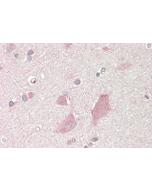Cookie Policy: This site uses cookies to improve your experience. You can find out more about our use of cookies in our Privacy Policy. By continuing to browse this site you agree to our use of cookies.
AdipoGen Life Sciences
anti-NMNAT2 (human), pAb

This antibody has been tested in immunohistochemistry, analyzed by an anatomic pathologist and validated for use in IHC applications against formalin-fixed, paraffin-embedded human tissues. The image shows the localization of the antibody as the precipitated red signal, with a hematoxylin purple nuclear counterstain.
1: Human NMNAT2 (His-tagged) (50ng).
2: Human mesenchymal stem cell lysate (V1T1) (50μg).
3: Unrelated Protein (His-tagged) (50ng).
| Product Details | |
|---|---|
| Synonyms | Nicotinamide Mononucleotide Adenylyltransferase 2; NMN Adenylyltransferase 2; NaMN Adenylyltransferase 2 |
| Product Type | Polyclonal Antibody |
| Properties | |
| Source/Host | Guinea pig |
| Immunogen/Antigen | Recombinant human NMNAT2. |
| Application |
ELISA: (direct and indirect: 1:2’000-1:5’000) Note: Tested on recombinant proteins and/or target-protein transfected cell lines in ELISA, Western Blot and/or FACS. |
| Crossreactivity | Human |
| Specificity |
Recognizes human NMNAT2. Detects a band of ~35kDa by Western blot. Not tested in other species. |
| Purity Detail | Protein A-affinity purified. |
| Concentration | 1 mg/ml |
| Formulation | Liquid. 0.2μm-filtered solution in PBS, pH 7.4. Contains no preservatives. |
| Shipping and Handling | |
| Shipping | BLUE ICE |
| Short Term Storage | +4°C |
| Long Term Storage | -20°C |
| Handling Advice |
After opening, prepare aliquots and store at -20°C. Avoid freeze/thaw cycles. |
| Use/Stability | Stable for at least 6 months after receipt when stored at -20°C. |
| Documents | |
| MSDS |
 Download PDF Download PDF |
| Product Specification Sheet | |
| Datasheet |
 Download PDF Download PDF |
NMNAT2 catalyzes the formation of NAD+ from nicotinamide mononucleotide (NMN) and ATP. Can also use the deamidated form nicotinic acid mononucleotide (NaMN) as a substrate but with lower efficiency. Also catalyzes the reverse reaction, i.e. the pyrophosphorolytic cleavage of NAD+. Highly expressed in brain, in particular in cerebrum, cerebellum, occipital lobe, frontal lobe, temporal lobe and putamen. Also found in the heart, skeletal muscle, pancreas and islets of Langerhans. Has been shown to correlate with Alzheimer’s disease in APPswe/PS1dE9 transgenic mice and delayed wallerian degeneration in cultured superior cervical ganglia (SCGs) from morphological changes, microtubule destruction and neurofilament degradation.






